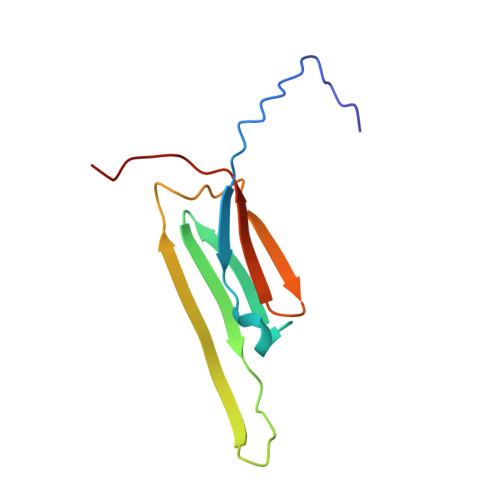Structure of the alpha-crystallin domain from the redox-sensitive chaperone, HSPB1.
Rajagopal, P., Liu, Y., Shi, L., Clouser, A.F., Klevit, R.E.(2015) J Biomol NMR 63: 223-228
- PubMed: 26243512
- DOI: https://doi.org/10.1007/s10858-015-9973-0
- Primary Citation of Related Structures:
2N3J - PubMed Abstract:
Small heat shock proteins (sHSP) are a class of ATP-independent protein chaperones found throughout nature. They share a common ability to maintain partly unfolded proteins in soluble states under cellular stress conditions. All sHSPs contain a central domain called the α-crystallin domain (ACD); the domain is found in all sHSPs and in no other proteins and therefore defines the family. Though most sHSPs form large, often polydisperse oligomers from varying numbers of subunits, the ACD is both necessary and sufficient for formation of a dimer, the fundamental building block for oligomers. HSPB1 (also known as Hsp27) is unique among the ten human sHSPs because it contains a Cys residue in its dimer interface. HSPB1 is highly expressed under conditions of oxidative stress and is proposed to serve as a redox-sensitive chaperone. HSPB1 residue Cys137 has been proposed to modulate function by existing in either its oxidized (disulfide) or reduced (thiol) form (Chalova et al 2014). Here we report the solution-state NMR structure of oxidized HSPB1-ACD and compare it to a previously determined crystal structure of the reduced state. Formation of the disulfide-bond across the dimer interface yields a locked dimer structure with increased accessible hydrophobic surface. In the context of full-length HSPB1 oligomers, oxidation of Cys137 is associated with enhanced ability to bind the hydrophobic dye, 8-Anilinonapthalene-1-sulfonic-acid, implying an increased ability to interact with client proteins under oxidative stress.
- Department of Biochemistry, University of Washington, Seattle, WA, 98195-7350, USA.
Organizational Affiliation:
















